October 10, 2025
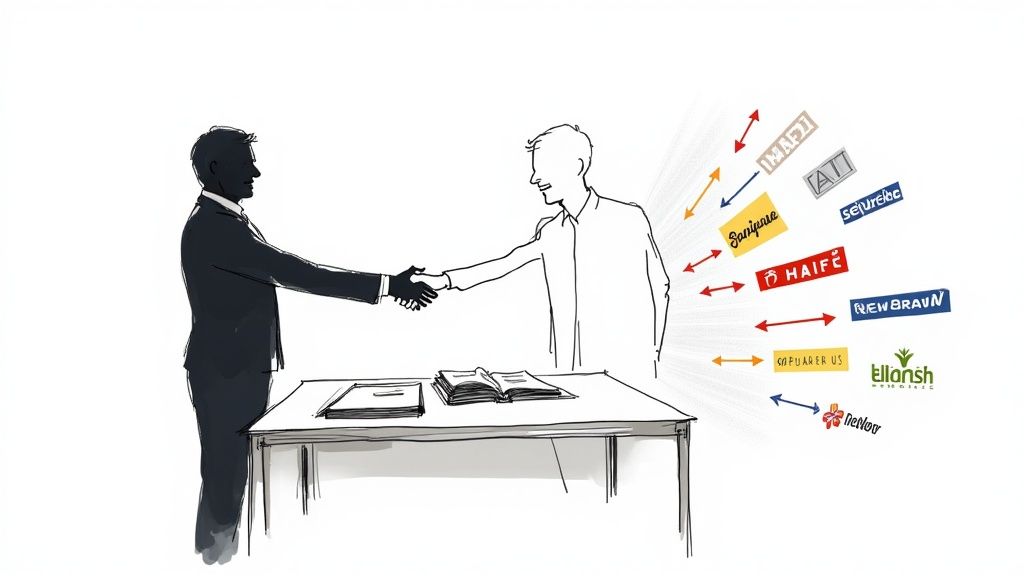
Getting sponsors for your event really boils down to four things: knowing your audience inside and out, creating packages they can't resist, finding partners who are a natural fit, and proving your event is worth their investment. When you get this right, you’re not just asking for money—you're presenting a strategic business opportunity.
Before you even think about drafting an email or picking up the phone, the most critical work for securing sponsors happens behind the scenes. Let’s be clear: successful sponsorship isn't about asking for a handout. It's about building a rock-solid business case that shows your event is a prime marketing channel. This is where you turn your event's potential into a tangible asset.
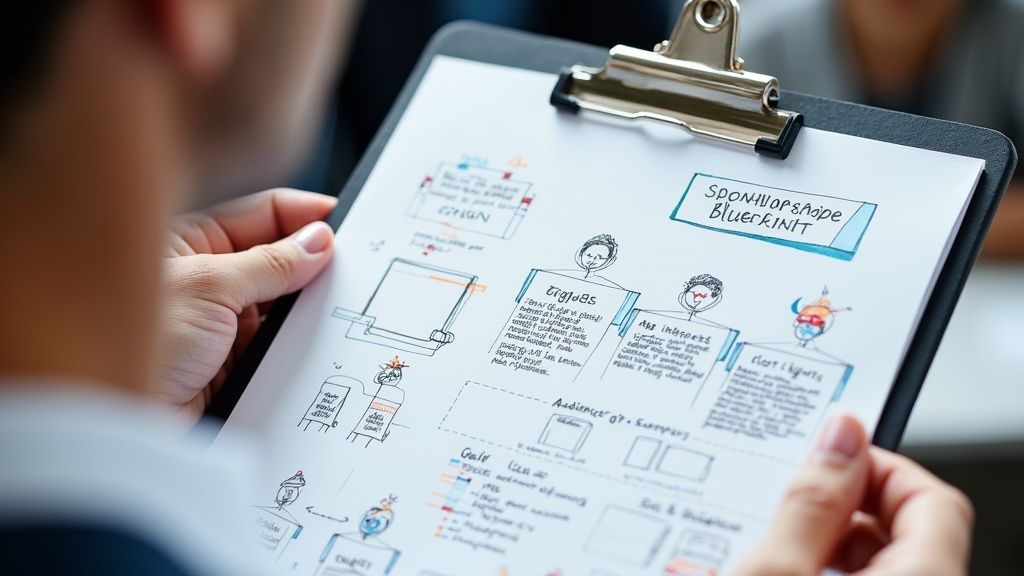
The first step is a mental shift. You're not just an event planner. You're a gatekeeper offering direct access to a highly engaged, targeted audience. Before reaching out, it really helps to understand the core principles of strategic partnership. This changes the entire conversation from a simple transaction to one about mutual growth.
Sponsors don't pay for a headcount; they pay for access to their ideal customers. Just saying you have a crowd isn't enough. You need to paint a vivid picture of who is actually in the room.
Instead of saying, "we expect 500 tech professionals," get specific. Think like a marketer:
When you have this level of detail, a potential sponsor immediately sees their target customer in your audience. It makes their decision to partner with you a no-brainer.
What do you actually need the money for? "Funding" is way too vague. You have to break down your objectives with precision because this will directly shape who you approach and what you offer them.
Your goal isn't just to cover costs—it's to enhance the attendee experience and deliver measurable value to your partners. The magic happens when you can clearly define what a win looks like for everyone involved.
Think about the different kinds of support that could move the needle for your event:
Defining these goals lets you approach companies with specific, tailored asks that make perfect sense for their business. It's also the backbone for creating compelling event sponsorship packages.
Sponsorship has moved way beyond just slapping a logo on a banner. Modern brands are laser-focused on partnerships that reflect their corporate values. Things like social impact and sustainability are no longer buzzwords; they're deal-breakers.
Companies are actively seeking events that show a real commitment to diversity, equity, and inclusion, or that have a solid plan for reducing their environmental footprint. This is especially true for brands trying to connect with younger audiences, who are known for putting their money where their values are.
By building this strong foundation—knowing your audience, defining your goals, and understanding a sponsor's needs—you completely change the dynamic. Your outreach shifts from a hopeful request to an irresistible business opportunity.
Forget the "spray and pray" approach. Sending out a hundred generic proposals is a massive waste of your time and energy. The real secret to landing great event sponsors isn’t about how many companies you contact; it’s about which ones you contact.
Your goal should be a short, highly-targeted list of brands whose ideal customer is sitting in your audience. When you get this right, the entire dynamic changes. You’re no longer asking for a handout. Instead, you're presenting a can't-miss business opportunity. It’s a completely different conversation—and one that gets you to "yes" a lot faster.
The first question you should always ask is: "Who is already trying to sell things to my attendees?" This simple mindset shift is the best way to kickstart your prospect list.
Really dig into who your ideal attendee is. What brands do they already follow and buy from?
The connection has to feel natural. When a brand sees their target demographic perfectly mirrored in your event audience, your job becomes infinitely easier.
Want to know the best indicator of a company's interest? Look at what they've already done. You’re looking for brands that are already active in event marketing because it tells you two crucial things: they get the value, and they have a budget for it.
Start by looking at events that are similar to yours in size, theme, and audience. Go to their websites and find the "Our Sponsors" or "Partners" page. This is basically a pre-qualified list of prospects handed to you on a silver platter.
A company's past sponsorship is the strongest signal of future interest. It proves they have a budget, they understand the value, and they have a team in place to manage event partnerships.
Once you have a few names, dig a little deeper. Check out industry news, press releases, or even just search on social media to see which brands consistently have a presence at trade shows and conferences in your field.
This infographic breaks down a simple process for zeroing in on the most promising companies.
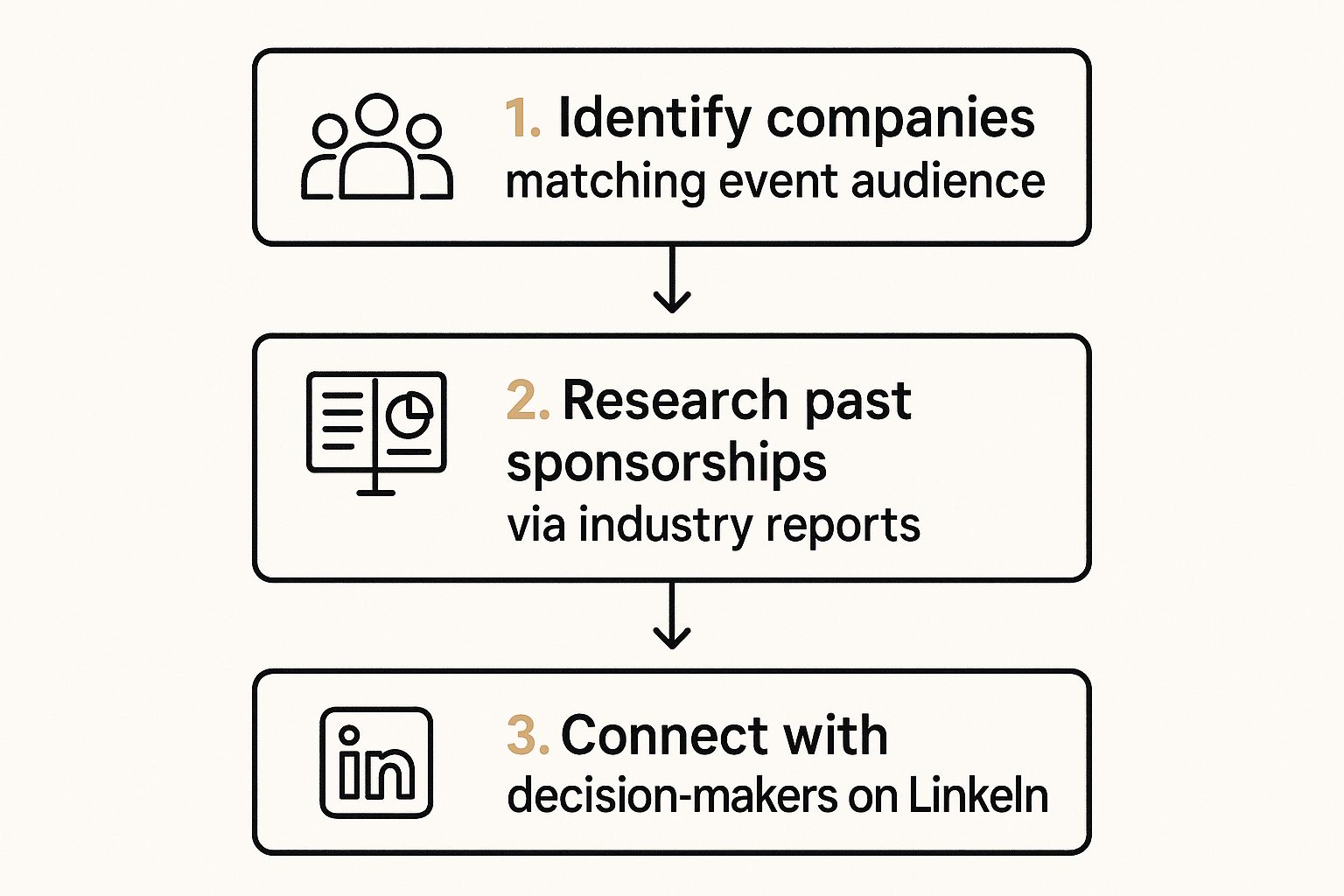
Following a clear workflow like this keeps you from wasting time on companies that were never going to be a good fit in the first place.
Okay, so you've found the perfect company. That's only half the job. Now you have to get your proposal in front of the right person. Sending a brilliant pitch to a generic "info@" email is like throwing it directly into a black hole.
This is where LinkedIn becomes your best friend. Your proposal needs to land in the inbox of someone who actually manages the sponsorship budget. Search for job titles like:
With smaller, local companies, you might just reach out to the owner directly. But for bigger corporations, you’re almost always looking for someone in the marketing department.
Taking the time to find a specific person and personalize your outreach will make a night-and-day difference in your response rate. For a deeper dive, our guide on how to find corporate sponsorship has even more strategies you can use. This is a non-negotiable step if you want to get serious about event sponsorship.
Let's be blunt: your sponsorship proposal is your make-or-break sales document. If you’re sending out a generic, one-size-fits-all template, you’re basically fast-tracking it to the trash folder. To get a "yes," you have to fundamentally shift your mindset. You're not asking for a handout; you're presenting a strategic marketing investment plan designed specifically for your prospect.
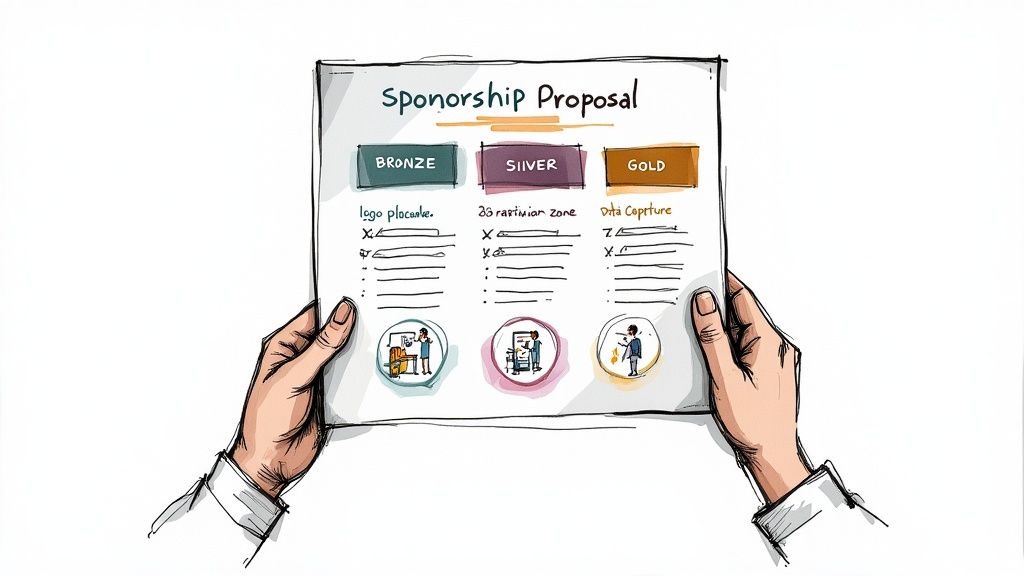
This document is where you connect the dots for them. You've already done the hard work of identifying your audience and finding what you think is a perfect sponsor—now it's time to prove it. You need to show them, in black and white, why partnering with your event is an opportunity they can't afford to miss.
You’ve got about ten seconds to hook them. Don't waste a single word on fluff. Your executive summary needs to be a sharp, concise pitch that immediately tells the sponsor what your event is, who attends, and most critically, why it should matter to their business.
This isn't the place for a long-winded history of your event. Think of it as the movie trailer—it needs to be exciting, crystal clear, and leave them wanting to know more.
No company sponsors an event out of pure altruism. They expect a return, and your proposal needs to speak that language. Ditch words like "donation" or "support." Instead, frame the conversation around "partnership," "investment," and "marketing activation."
Your entire proposal must proactively answer the sponsor's biggest question: "What's in it for me?" That answer should be the common thread weaving through every section, drawing a direct line from their investment to real business outcomes like lead generation, brand lift, or deep community engagement.
The game has changed. Brands aren't just paying for logo placement anymore. They demand partnerships backed by data that deliver measurable value and authentic connections. This isn't a guess; it's a fact, with 88.4% of event marketers confirming sponsorships are a major key to driving event revenue. If you want to dive deeper into this, Eventeny has a great breakdown of what brands want in 2025.
Offering sponsorship levels—like Platinum, Gold, and Silver—is a standard for a reason: it simplifies the decision-making process. It gives potential partners clear, distinct options with escalating value.
But don't just phone it in by adding a few more logo placements to the higher tiers. Get creative and think about what each level of investment can unlock.
A well-structured tier system makes the mid-level option seem like the obvious, high-value choice, while the top tier presents a premium, exclusive opportunity for the right partner. Below is a simple table to help you visualize how to present these benefits clearly.
This table illustrates how you can present your packages to potential sponsors, making it easy for them to compare the value at each level.
By laying it out this way, you remove any guesswork and help sponsors see exactly what they're investing in.
Pro Tip: Your goal with tiered packages is to make the mid-level option so compelling that it becomes the default choice, while the top tier feels like an exclusive, high-impact opportunity for the perfect partner.
If you’re looking for a solid starting point, check out this guide on how to build a sample sponsorship proposal that breaks it down with great examples.
The proposals that really stand out are the ones that offer creative activation ideas—things that go way beyond just slapping a logo on a banner. Sponsors crave memorable experiences that connect their brand with your audience in a meaningful way. Your proposal should be a canvas of these possibilities.
Here are a few ideas to get you started:
When you present these kinds of ideas, you’re showing that you're not just asking for money—you're thinking like a true partner invested in their success.
Finally, make sure your proposal looks as good as it reads. A polished, professionally designed document instantly reflects the quality and credibility of your event. If you need some inspiration for structuring your pitch, reviewing some business proposal letter samples can be incredibly helpful.
Your final document should be a sharp, compelling argument that makes saying "yes" an easy and intelligent business decision.
A fantastic proposal might get your foot in the door, but it’s the outreach and negotiation that seal the deal. This is where all that research you did really starts to pay dividends, letting you turn a cold pitch into a genuine conversation about mutual success.
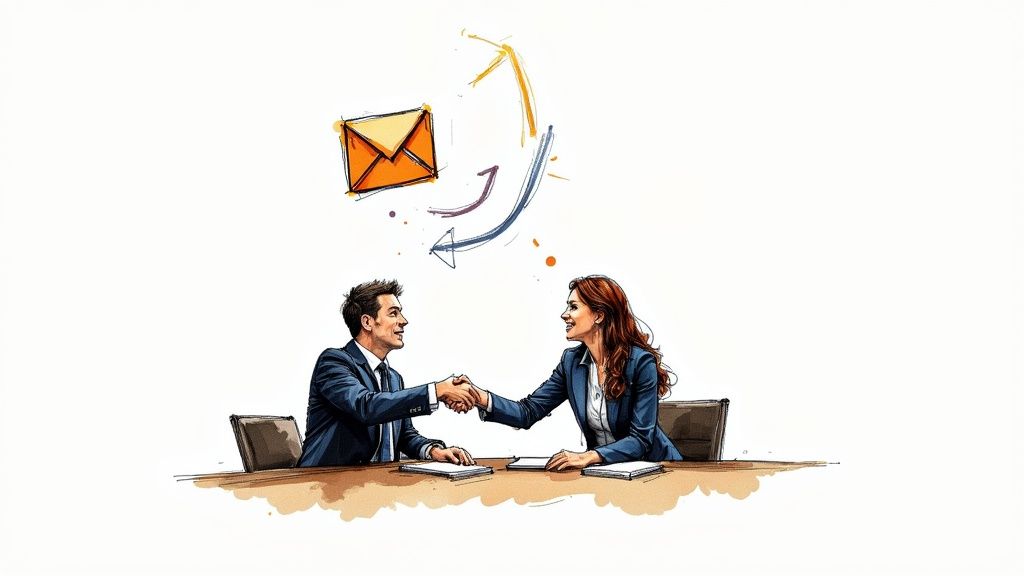
That first email is your make-or-break moment. We’ve all seen—and immediately deleted—those generic, mass-sent messages. To cut through that noise, personalization is your secret weapon. It shows you’ve actually done your homework.
Your first point of contact needs to be sharp, to the point, and focused entirely on what’s in it for them. A cardinal rule: never lead by asking for money. Instead, open with the value you can bring to their brand.
A solid outreach email does a few things really well:
Don't just send it and forget it. A polite follow-up is essential. I usually wait about a week, then send another gentle nudge two weeks after that. People are busy, and a quick reminder often lands on an appreciative desk.
A personalized pitch isn’t just about flattering them. It fundamentally changes the dynamic from a transaction to a partnership. It communicates respect for their brand and instantly sets you apart.
So you’ve landed the meeting. Great. Now the real work begins. This is your chance to listen more than you talk, to truly understand their marketing challenges, and to position your event as the perfect solution.
The most common objection you’ll hear is the classic, "It's not in the budget." Don’t take that as a final "no." Instead, see it as an invitation to get creative.
Try asking a few questions to dig deeper:
This approach completely reframes the discussion. It’s no longer a simple "yes/no" but a collaborative session to find a solution. It shows you're flexible and genuinely invested in making it work for them. For a deeper dive into structuring these conversations, our guide on how to ask for a sponsorship has more detailed scripts and strategies.
Ultimately, a good negotiation is all about finding that win-win. You absolutely need to know your bottom line—the minimum you can accept—but always be ready to customize. The goal isn't to squeeze every last dollar out of them; it's to build a strong partnership that delivers so much value they can't wait to sign up again next year.
Getting that signature on the sponsorship agreement feels great, doesn't it? But that's the starting line, not the finish. The real work starts now. This is where you shift from pitching to performing, and it’s what separates a one-time transaction from a partnership that fuels your event year after year.
Let’s be honest, the goal isn’t just to get sponsors; it’s to keep them. Turning a first-timer into a loyal partner is how you build a truly sustainable event. This all comes down to a proactive, hands-on approach to managing the relationship from the second the ink is dry.
"We'll figure it out on the day" is a recipe for disaster. You can't just hope a sponsor’s benefits will magically appear. A detailed sponsorship activation plan is your roadmap, your promise in writing, outlining every single deliverable you sold them on.
Think of it as the master checklist for both your team and theirs. It should be a living, shared document that covers every commitment, no matter how small.
This level of organization does more than just keep you on track—it screams competence. When a sponsor sees you’ve got a plan this detailed, they can relax, knowing their investment is in good hands.
Event day is organized chaos, but for your sponsors, it should feel like a VIP experience. They can't feel like an afterthought you’ll get to eventually.
This is why I always assign a dedicated point of contact—a "Sponsor Concierge"—whose only job is to look after them. This person should be there to greet them with a smile, walk them to their booth, confirm their speaking time, and be their go-to for any little thing that comes up. A simple, "How's the traffic at your booth?" or "Can I grab you a coffee?" makes a world of difference.
A sponsor who feels ignored on event day is a sponsor who will not be back next year. Your goal is to make them feel seen, supported, and successful from the moment they arrive until the last attendee leaves.
Once the lights are off and you've finally had a chance to breathe, one critical task remains: proving you delivered. A comprehensive post-event report is your single most powerful tool for locking in that renewal. This isn’t a fluffy thank-you note; it’s a business case packed with data that proves their ROI.
Make it look professional, make it easy to read, and fill it with the metrics that matter to their bottom line.
What to Pack into Your Sponsorship Report:
This data-first approach is more important than ever. The sponsorship game is getting more sophisticated, especially with virtual and hybrid events that give us even more data to track. The global sports sponsorship market alone is expected to jump from $60.17 billion in 2024 to $132.86 billion by 2033, and that growth is fueled by this demand for measurable results. You can discover more insights about the evolving sponsorship market and its digital transformation to better position your event's value.
When you hand them a report filled with hard evidence, the renewal conversation changes completely. It goes from "Should we do this again?" to "This was great. How can we go even bigger next year?"
Let's be honest, sponsorship can feel like a maze. No matter how many events you've run, the same questions and roadblocks always seem to pop up. Here’s some straightforward advice, straight from the trenches, to help you clear those hurdles.
Pricing isn't just about picking a number that feels right. The single biggest mistake I see is when planners guess. Instead, anchor your pricing in reality.
First, get a firm grip on your event's total production cost. I mean everything—from the venue deposit and speaker fees down to the Wi-Fi and marketing spend. This number is your baseline, your break-even point.
Then, you need to think like a marketer and assign a real-world value to every single asset you're offering. What's the going rate for a sponsored email to your list of 5,000 industry leaders? How much would a company pay for a speaking slot or a prime booth right by the coffee station? Do some digging and see what comparable events are charging. When you combine your costs with the tangible marketing value you provide, you get a price range that you can actually defend.
Key Takeaway: You're not selling space for a logo. You are selling direct access to a highly curated audience. Your pricing should reflect that marketing value, not just what it costs to keep the lights on.
Don't panic. A lack of past attendance figures isn't a dead end. It just means you have to work a little harder to sell the dream and the potential. Without hard numbers, your job is to paint an irresistible picture of who will be in that room and why a sponsor needs to meet them.
Here's how you build a rock-solid case from scratch:
Ultimately, you need to make them feel secure about their investment. A well-researched and confident plan shows them that even without a track record, your event is a very smart bet.
Sending a generic, "To Whom It May Concern" email into the void of a corporate contact form? Yes, that's a complete waste of your time. But sending a sharp, personalized email directly to the right person? That's one of the most powerful moves you can make.
The secret is to forget the shotgun approach. Don't blast a list of 100 potential sponsors. Instead, meticulously research five companies that are a perfect match and pour your energy into crafting a message they simply can't ignore.
Use LinkedIn to find the person who actually manages partnerships or the brand manager for the relevant product line. In your email, show you've done your homework. Reference a recent product launch or a new marketing campaign they're running. Draw a straight line between their current goals and your audience.
Something as simple as, "I noticed your new push into the enterprise software market, and I thought you’d be interested to know that 60% of our attendees are C-level tech executives," changes the entire dynamic. The goal of that first email isn't to sign a contract; it's just to start a real conversation.
GroupOS is the all-in-one platform built to help you manage your community and event sponsorships without the headache. With dedicated sponsor profiles, powerful analytics to prove ROI, and easy-to-use communication tools, you can deliver incredible value and turn sponsors into long-term partners. See how GroupOS simplifies growth and start your free trial today.


